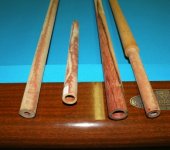Nathan, there are many ways to build cues and for many of us trial and error is main way we learn. I have made the mistakes you are asking about here, I have had A-joints move on finished cues and I have had problems with the butt sleeve tenon.
So keeping all this in mind I have made the following changes where the butt sleeve is concerned, and to date it has eliminated any butt sleeve movement. It also allows the cues balance point to be moved to any position the customers requests, and last butt not least it makes the cue butt very very strong, and this in my opinion is important because a cues butt is one of the most abused area's on any cue.
In the pictures below I am going to show you my technique for Butt Tenon's. Many will not do it this way, because of the added expense or the additional work required, or because they simply do not think this is necessary. However, it works well for me and it totally stabilizes the entire butt section of the cue. In addition the method of construction will not move or ever warp. I start by deciding what the length of the cue will be. Next I bore a .750 diameter hole two and one half inches deep into the cues butt, then I epoxy the Phenolic tube into the cues butt. When I prepare the tube I only turn down the section going into the cues butt to .750 diameter. After the epoxy has set ( 24 hr's ) I install the core into the Phenolic Tube also using expoy, the inside tube diameter is .623 so the core is turned to that diameter. This core can be threaded prior to installation in the tube or after the epoxy has set, I normally thread the cure before I put it in the tube.
Then the remaining exposed tube can be turned down to what ever diameter you choose so that you can add your cored butt pieces, I normally use sections of wood for a cues butt that are bored out to .750.
Here are the photo's:
View attachment 191809
View attachment 191810
View attachment 191811
View attachment 191812
Please don't laugh, I am also a Noob but I am having fun even though this will most likely never make me rich!!!:smile:





